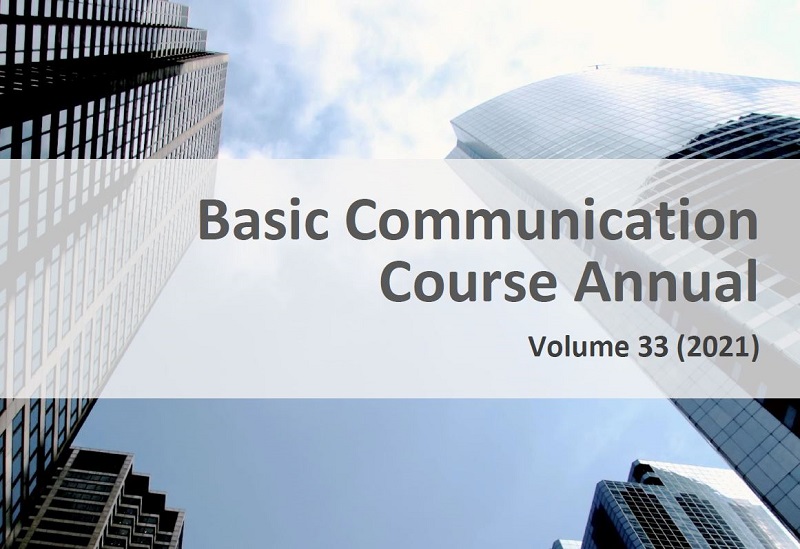University Libraries

Wednesday January 27, 2021
Basic Communication Course Annual releases Volume 33
By Brandi N. Frisby
Volume 33 of the Basic Communication Course Annual, a peer-reviewed open-access journal highlighting scholarship related to the popular and often required college course in public speaking and interpersonal communication, is now available on eCommons, the University of Dayton’s institutional repository.
Highlights from Volume 33:
- The Neutrality Myth: Integrating Critical Media Literacy into the Introductory Communication Course — Meggie Mapes, Lindsey Kraus, Elnaz Parviz and Joshua Morgan of the University of Kansas provide insight on how to teach students to be more active producers of media, rather than passive consumers.
- Critical Pedagogy of Preparation: Structuring Best Practices for Introductory Course Relevance — Daniel Chick of the University of Kansas focuses on developing active and prepared citizens.
- Student Perceptions of Value: A Qualitative Study of Student Experiences in the Communication Center — Briana Stewart, Andie Malterud, Heidi Lawrence and Melissa Broeckelman-Post explore student responses to a new communication center (known on some campuses as speech labs, communication labs or speaking centers).
- The Impact of Communication Center Visits on Students’ Performance and Engagement — Nate Brophy, Adebanke Adebayo and Broeckelman-Post explore the influence of the communication center on students’ performance.
- ‘Public Speaking is a Skill that Everyone Needs No Matter What’: Exploring Peer Perceptions toward Students on the Autism Spectrum in Basic Course Classrooms — Jill Underhill, Victoria Ledford and Hillary Adams tackle the need for research to address diverse student populations.
- A 14-Year Empirical Analysis of Undergraduates’ Pre- and Post-Test Scores in Three Introductory Communication Courses: Lessons Learned for Pedagogy and Assessment — Sherwyn Morreale, Pamela Shockley-Zalabak, Barbara Gaddis, Janice Thorpe, Constance Stanley and Erica Allgood analyze data from 9,707 students and provide practical advice to guide basic course directors’ assessment efforts.
- A Longitudinal Analysis of Student Learning Gains in Oral Competency — Lynn O. Cooper, Rebecca Border Sietman and John Vessey share learning gains between informative and persuasive speeches for over 2,000 students over 10 years.
- A Longitudinal Analysis of Student Learning Gains in Oral Competency — Chris Sawyer, Delwin Richey and Karley Goen apply regulatory fit theory to examine students’ emotional responses to evaluation.
- Thriving Instead of Surviving: The Role of the Reasoned Action Model in Assessing the Basic Course — Michael Burns, Kristen Farris, Mark Paz and Sean Dyhre apply the reasoned action model to understand students’ intentions to use skills learned in the basic course outside of class.
- Teacher Immediacy Behaviors and Students’ Public Speaking Anxiety: More and Less Helpful than Anticipated — Framed by the instructional beliefs model, Beau Foutz, Michelle Violanti, Stephanie Kelly and Suzy Prentiss examine a model depicting the relationships between immediacy and the reduction of public speaking anxiety.
- Vocal Fillers, Contagion Effects, and, um, Overlooked Pedagogical Opportunities in the, uh, Public Speaking Classroom — W. Benjamin Myers and Theresa A. Wadkins experimentally examine social contagion effects, finding that sample speeches with vocal fillers resulted in more vocal fillers.
- Managing Graduate Teaching Assistant Misbehaviors: Perspectives of Basic Course Directors from the Front Porch — Michelle Hershberger identifies the most common misbehaviors of graduate teaching assistants and setting a foundation for approaches to training and management.
- In a series of short essays, Ashley A. Hanna Edwards, Kody Frey, Nicholas T. Tatum, Troy B. Cooper, Suzy Prentiss and Jon Hess discuss the tailoring of communication skills to meet and match employer’s needs, addressing mentorship, digital skills and what workforce skills might look like in a post-COVID-19 world.
All articles are free and available worldwide. To browse all volumes, see the journal website. Submissions are now welcome for Volume 34; the deadline is Oct. 1, 2021.
Share
Topics
